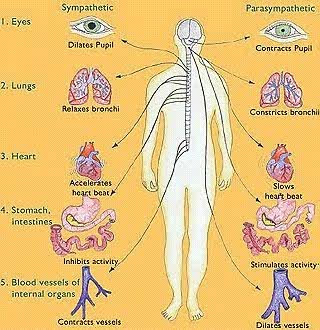The Polyvagal Theory (gr. 'polus', “‘many’” + 'vagal', "'Vagus Nerve'") was proposed and developed by Dr. Stephen Porges, Director of the Brain-Body Center at the University of Illinois at Chicago.
The theory specifies two functionally distinct branches of the vagus, or tenth cranial nerve. The branches of the vagal nerve serve different evolutionary stress responses in mammals: the more primitive branch elicits immobilization behaviors (e.g., feigning death), whereas the more evolved branch is linked to social communication and self-soothing behaviors.
These functions follow a phylogenetic hierarchy, where the most primitive systems are activated only when the more evolved structures fail. These neural pathways regulate autonomic state and the expression of emotional and social behavior.
Thus, according to this theory, physiological state dictates the range of behavior and psychological experience. Polyvagal theory has many implications for the study of stress, emotion, and social behavior, which has traditionally utilized more peripheral indices of arousal, such as heart rate and cortisol level.
The measurement of vagal tone in humans has become a novel index of stress vulnerability and reactivity in many studies of populations with affective disorders, such as children with conduct problems and those suffering from borderline personality disorder.
Phylogenetic Subsystems/Stages
The vagus nerve is a primary component of the autonomic nervous system. Polyvagal theory outlines the structure and function of the two distinct branches of the vagus, both of which originate in the medulla.
More specifically, each branch is associated with a different adaptive behavioral strategy, both of which are inhibitory in nature via the parasympathetic nervous system (PNS).
The vagal system is in opposition to the sympathetic-adrenal system, which is involved in mobilization behaviors. According to polyvagal theory, these opposing systems are phylogenetically arranged.
The Dorsal Vagal Complex
The dorsal branch of the vagus originates in the dorsal motor nucleus and is considered the phylogenetically older branch. This branch is unmyelinated and exists in most vertebrates. This branch is also known as the “vegetative vagus” because it is associated with primal survival strategies of primitive vertebrates, reptiles, and amphibians. Under great stress, these animals freeze when threatened, conserving their metabolic resources.
The DVC provides primary control of subdiaphragmatic visceral organs, such as the digestive tract. Under normal conditions, the DVC maintains regulation of these digestive processes. However, prolonged disinhibition can be lethal for mammals, as it results in apnea and bradycardia.
The Ventral Vagal Complex
With increased neural complexity seen in mammals (due to phylogenetic development) evolved a more sophisticated system to enrich behavioral and affective responses to an increasingly complex environment.
The ventral branch of the vagus originates in the nucleus ambiguus and is myelinated to provide more control and speed in responding. This branch is also known as the “smart vagus” because it is associated with the regulation of sympathetic “fight or flight” behaviors in the service of social affiliative behaviors.
These behaviors include social communication and self-soothing and calming. In other words, this branch of the vagus can inhibit or disinhibit defensive limbic circuits, depending on the situation.
The VVC provides primary control of supradiaphragmatic visceral organs, such as the esophagus, bronchi, pharynx, and larynx. The VVC also exerts important influence on the heart.
When vagal tone to the heart’s pacemaker is high, a baseline or resting heart rate is produced. In other words, the vagus acts as a restraint, or brake, limiting heart rate. However, when vagal tone is removed, there is little inhibition to the pacemaker, and so rapid mobilization (“fight/flight”) can be activated in times of stress, but without having to engage the sympathetic-adrenal system, as activation comes at a severe biological cost.
Vagal Tone: A Physiological Marker of Stress
In order to maintain homeostasis, the central nervous system responds constantly, via neural feedback, to environmental cues.
Stressful events disrupt the rhythmic structure of autonomic states, and subsequently, behaviors. Since the vagus plays such an integral role in the PNS via regulation of heart rate, it follows that the amplitude of respiratory sinus arrhythmia (RSA) is a good index of PNS activity via the cardiac vagus.That is, RSA is a measurable, noninvasive way to see how the vagus modulates heart rate activity in response to stress. This method is useful to measure individual differences in stress reactivity.
RSA is the widely used measure of the amplitude of heart rate rhythm associated with rate of spontaneous breathing. Research has shown that amplitude of RSA is an accurate indicator of the efferent influence of the vagus on the heart. Since inhibitory effects of the VVC branch of the vagus allow for a wide range of adaptive, prosocial behaviors, it has been theorized that individuals with greater vagal tone are able to exhibit a greater range of such behaviors.
On the other hand, decreased vagal tone is associated with illnesses and medical complications that compromise the CNS. These complications may reduce one's capacity to respond to stress appropriately.
Clinical Applications of Polyvagal Theory and Vagal Tone
Vagal tone has been used in medical and psychological research to better understand the physiological underpinnings of various disorders.
For example, healthy human fetuses have a high variability in heart rate, which is mediated by the vagus. On the other hand, heart rate decelerations, which are also mediated by the vagus, are a sign of fetal distress.
More specifically, prolonged withdrawal of vagal influence on the heart creates a physiological vulnerability to the influence of the DVC, which in turn produces clinically relevant bradycardia. However, the onset of this deceleration is commonly preceded by transitory tachycardia, which is reflective of the immediate effects of VVC withdrawal.
For more:
"How your nervous system sabotages your ability to relate" an interview with Stephen Porges about his polyvagal theory by Ravi Dykema
http://www.nexuspub.com/articles_2006/interview_porges_06_ma.php

No comments:
Post a Comment